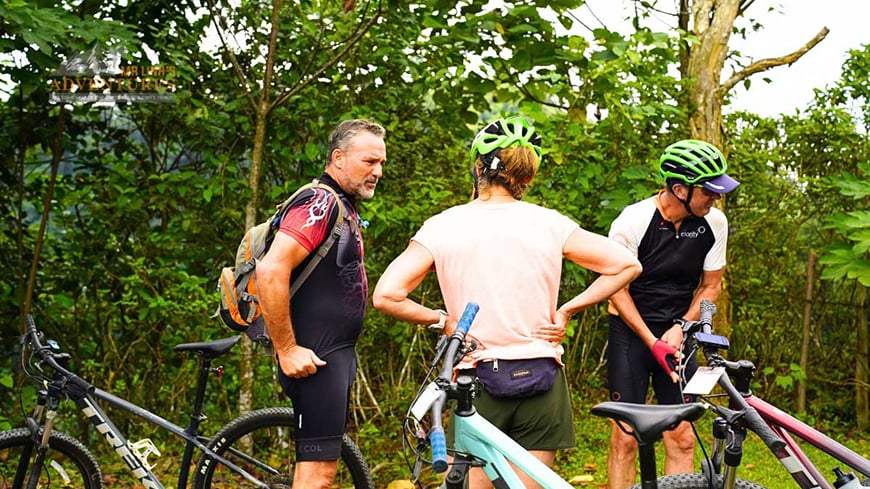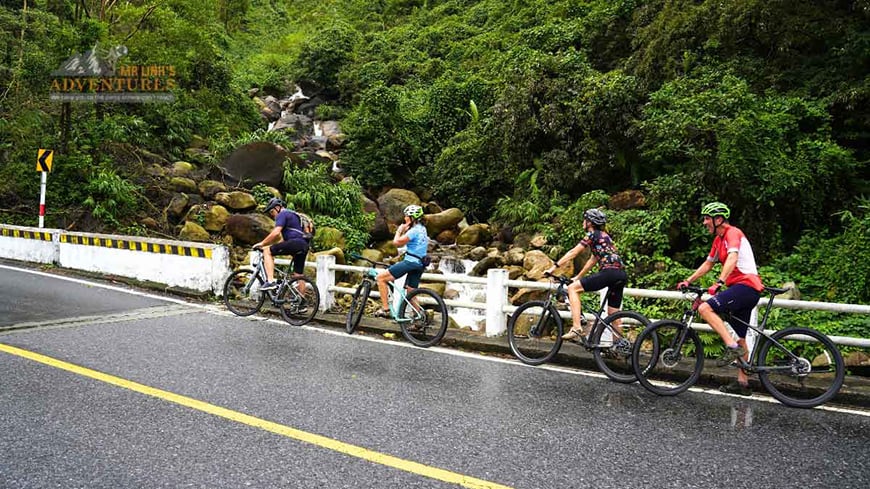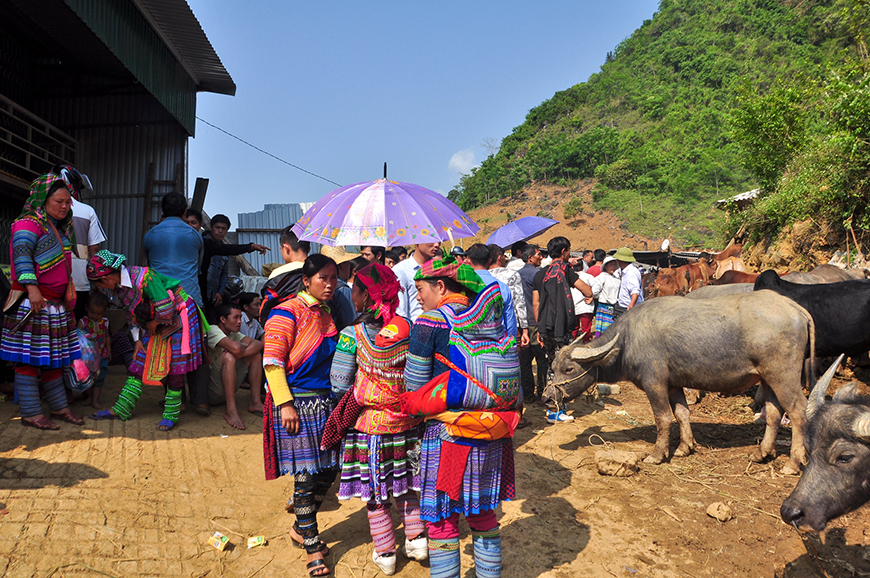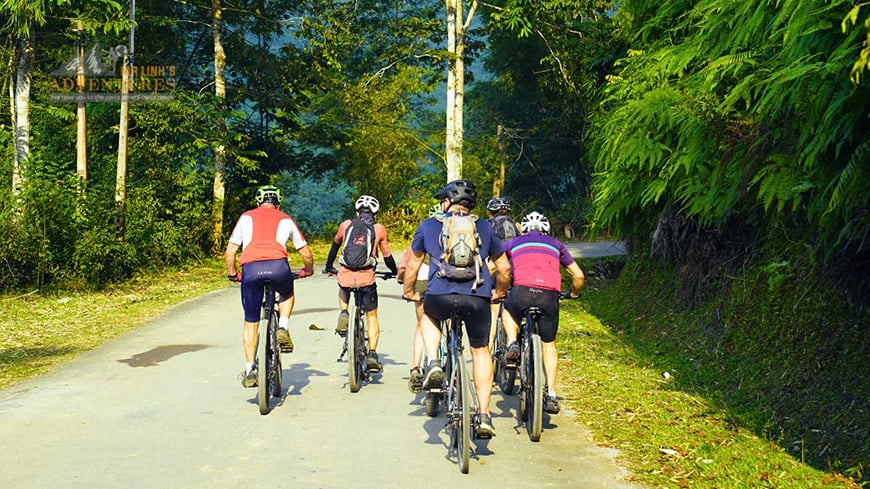Preface by the adventurer who returned from the rice fields
You want to go on an XXL cycling trip. You've already ruled out Corsica and the Alps because “it's too clean, too expensive, too common, and anyway, there's no Banh Mi.” So you thought of North Vietnam. Good choice. Wise decision.
The Tonkin of yesteryear is a playground where geography has decided to let loose between 450 m and 2,000 m above sea level. Imagine the Alps, but with rice fields that form waves of gold, mischievous monkeys instead of marmots, and 500 kilometers of hairpin turns offering a cultural slap in the face at every bend. And a Banh Mi for lunch.
This guide is my road book, the one I wish I had had before tackling Ma Pi Leng with a chain that squealed with exhaustion. Help yourself.
Cycling in North Vietnam: why you'll love it (and sweat)
Why has this corner of the world become the ultimate "must-ride" classic for bike lovers?
The real deal, authentic, no filter
No pretense here. The road winds through limestone gorges, hand-carved rice fields, and bamboo forests rustling with secrets. The mountain passes demand their toll, but the view repays you a hundredfold. And those buffaloes watching you climb the slopes as if you were some alien curiosity... That's the real deal.
Cultural immersion, freewheeling
Forget the "dances for tourists"15. I'm talking about the 25 ethnic groups that ride alongside the asphalt. This is daily life rolling out at your handlebars, not plasticized folklore. You are in it, not in front of it.
The "sweat / emotion" ratio is unbeatable
Expect between 1,000 and 2,500 m (approx. 3,300 to 8,200 feet) of daily elevation gain. Every climb is rewarded with 360° natural balcony: valleys marked by rice fields, sharp peaks tearing the clouds, and fog under your pedals. If you've never cried with emotion at the top of a pass, here, it's the norm.
Stress-free budget
Expect to pay $15-25 per day for rustic but generous comfort: clean room, new friends, local dishes, and cold beer to congratulate your calves. Every 20-30 km, you'll find a guesthouse, a cafe, and a local mechanic who fixes things with three tools and 15 years of experience. The anxiety of "where to sleep?" is replaced by "what am I eating tonight?" (Spoiler: sticky rice cooked in bamboo).
 Northern Vietnam : a bike‑backpack adventure | Mr Linh's Adventures
Northern Vietnam : a bike‑backpack adventure | Mr Linh's AdventuresIs this for me?
Yes, if you recognize yourself in one of these profiles:
✓ The cardio KO seeker: you tackle 1,000 meters of elevation gain before breakfast. Every pass is a 3D Strava. This is your terrain.
✓ The discerning traveler: Museums bore you, but a Hmong grandmother showing you how to dye indigo fascinates you. The bike is your passport.
✓ The slow traveler: You take your time, 30-90 km per day. You live the adventure; you don't endure it.
✓ The adventure family: You mix cycling + short transfers + kayaking + zip-lining for the teens. The kids get in the minibus when it gets too steep. Everyone meets up for a snack.
✓ The small budget, big dreams: 15-25 $/day (dormitory, meals and local guide).. Zero-star hotel, 5-heart experience.
In short: if you can ride for two hours without ending up in the hospital and the elsewhere calls you, North Vietnam opens its passes.
When to hit the North Vietnam roads?
There are two slots worth setting your alarm for 5 AM:
October – November (The Golden Season)
The mature rice turns the terraces into an ocean of gold. Stable sky, 20-28°C (68-82°F). Ha Giang shines. But everyone knows: book at least two weeks in advance or sleep in a tent.
March – April (The Blooming Season)
Peach and plum tree blossoms, with temperatures around 18-25°C (64-77°F). Fewer tourists. No crowd, no stress. Ideal for taking your time, adjusting your camera, and chatting for 20 minutes with a Dao grandmother without being rushed.
Periods to avoid (or to embrace)
June-September (Monsoon): Roads are like soap boards, 35°C (95°F), thunderstorms at fixed hours. You need to love the unpredictable and have carbon brakes.
December-February (Winter): Fog you can cut with a knife, 0°C (32°F) on the passes. It's beautiful, but freezing. And cycling in a down jacket is overrated.
 Pedaling the peaks of Vietnam’s north | Mr Linh's Adventures
Pedaling the peaks of Vietnam’s north | Mr Linh's AdventuresWhich "must-ride" itineraries?
The Ha Giang Loop – The Holy Grail
Distance: 350 km | D+: 7,000 m | Difficulty: Hard | Duration: between 3 and 5 days (ideally, 4-7 days)
Classic Route: Ha Giang → Quan Ba (Heaven’s Gate) → Yen Minh → Dong Van (UNESCO Geopark) → Meo Vac (Ma Pi Leng Pass, one of the most beautiful in the world) → Du Gia → Ha Giang
In practice (Sample 6-Day itinerary):
• Day 1: Ha Giang → Quan Ba (45km, 1,200m elevation gain). Stop at Tam Son, walk to Quan Ba market
• Day 2: Quan Ba → Yen Minh (70km). Lunch break in Lung Tam (Hmong textile village)
• Day 3: Yen Minh → Dong Van (50km). Visit to the Hmong king's palace
• Day 4: Dong Van → Meo Vac (25km) via the Ma Pi Leng pass. A magical day
• Day 5: Meo Vac → Du Gia (80km). Descent along the Nho Que river
• Day 6: Du Gia → Ha Giang (70km). Return via the scenic route
 Colorfull Bac Ha Market | Mr Linh's Adventures
Colorfull Bac Ha Market | Mr Linh's AdventuresSa Pa & The Ethnic Route
Distance: 150-200 km | D+: 3,500 m| Difficulty: Medium to hard | Duration: 2 to 4 days
Highlights: Terraced rice fields, ethnic villages (and tourists taking photos with buffaloes).
"Anti-Selfie" itinerary (to dodge the Instagram hordes): Sapa (overnight train) → Muong Hoa (hike) → Thanh Phu (80 km, 1,500 m D+) → Ta Van (homestay) → Bac Ha (Sunday market, 100% more authentic than Sapa) → return by Luc Yen (ruby mines).
Ba Be & Cao Bang, The Quiet Route
Distance: 250 km | D+: 4,000 \m | Difficulty: Medium | Duration: 4 to 6 days (to really enjoy yourself)
Highlights: Ba Be Lake (natural, few tourists), kayaking, caves, Ban Gioc Waterfall (the largest in Asia).
Itinerary: Hanoi → Thai Nguyen (road) → Ba Be National Park (lake, Tay homestay) → Pac Bo (Ho Chi Minh cave) → Ban Gioc Waterfall → return via Cao Bang
Other gems (If you have time or want to chill)
Mai Chau & Pu Luong (80 km / 2-3 days): Gentle, bucolic version (D+ < 800 m/day). For legs that need a break.
Ninh Binh (3 days): "Inland Ha Long Bay," flat roads, temples. For active rest days
Coastal route (5 days): Hai Phong → Ha Long → Mong Cai A mix of mountains and sea.
 The bike is the means. The experience is the end. | Mr Linh's Adventures
The bike is the means. The experience is the end. | Mr Linh's AdventuresLogistics & preparation
The ideal bike
Type: Trail MTB / Gravel with 1x11 ou 2x11 drivetrain. You need a minimum of 42 teeth on the rear cassette.
Tires: 40-50 mm tubeless is mandatory (Schwalbe Marathon, Pirelli Cinturato). Don't even discuss it.
Brakes: hydraulic. Essential on long 12% descents with 15 kg of luggage.
Carrying: Minimum 2 bottle cages, handlebar bag + rear panniers. Unless you want to end up paralyzed, no backpack.
Rental or purchase?
Rental in Hanoi: 15-25 $/day (decent MTB). Okay if you have no choice.
Purchase: A used Giant/Trek that you can resell on your return. The best option if you stay for more than 10 days.
The survival kit
Mechanics: Chain breaker, 2 inner tubes, patches, pump.
Tech: Garmin/Wahoo GPS with Vietnam OSM maps, 20,000 mAh solar battery.
Pharma: Anti-diarrheal, broad-spectrum antibiotics, compression bandages.
Papers & insurance
90-day E-visa: 25 USD to be asked on the
official website. Extension is impossible (you must apply again after leaving the territory).
Ha Giang Border Zone: Immigration permit ($10) to be obtened on site. Mandatory in border areas. Yes, even with an e-Visa. Your guide will take care of this.
Insurance:
MANDATORY: World Nomads or Chapka "Adventure" mentioning altitude and MTB. An accident on the Ma Pi Leng pass? That's a 15,000 $ medical helicopter. It's up to you...
Physical condition
Prepare yourself or earn it: long runs (3-4 hours), interval training, thigh strengthening.
Stay hydrated (1 liter/hour even at 15°C) and gradually increase your altitude.
 Cycling the hidden valleys of northern Vietnam | Mr Linh's Adventures
Cycling the hidden valleys of northern Vietnam | Mr Linh's Adventures
How does it work on site?
Bike transport
Expect eight hours for the bus journey from Hanoi to Ha Giang, at a cost of around $15. Bicycles are placed on the roof and protected in a bag. The train from Hanoi to Lao Cai (Sapa) also takes eight hours; a sleeper berth costs $20 and bikes can be stored in the luggage room for $5. This is the safest option. Finally, hiring a car with a driver costs $80-100 per day for a group, with bikes transported on the luggage rack. If there are 4 or 5 of you, this is the best option.
Accommodation
Ideally, stay with locals: ask for a “homestay” or “nha nghi” (guesthouse). Negotiate for a 20% discount.
Cozy spots in Ha Giang, Sa Pa, and Mai Chau that pamper cycle tourists: warm welcome, secure garage, sometimes rental or repair services, and just a stone's throw from the major routes. What's more, they can help you out if you need a pump, tools, or transfers. Your guide knows where to find them.
Safety & health
Vietnamese traffic law, or the new Darwinism:
Horn = "I am here". Use it. All the time. It's communicative, not aggressive.
Priority goes to the biggest: You are between the pedestrian and the scooter. Never dispute priority with a bus. Never.
Road safety: Narrow roads, zero visibility on bends, guardrails absent 30% of the time. Helmet MANDATORY.
Falls: 70% of accidents are on the descent. Check your brakes every morning.
Medical Emergencies: Number: 115 (ambulance), 113 (police).
.jpg) Cycling in Northern Vietnam with Mr Linh's Adventures
Cycling in Northern Vietnam with Mr Linh's AdventuresConclusion from the adventurer who wants to return
North Vietnam is not just ridden; it is lived through cycling.
Ride slowly. Get off the main road. Accept the invitation to drink tea with a guy who doesn't speak three words of English. Watch the children running alongside you, yelling "Hello!". That's where the magic happens.
You can have the best bike, the most beautiful jersey, the most expensive GPS... if you rush at 30 km/h in "I must hit my quota" mode, you've missed the point.
The bike is the means. The experience is the end.
So, once a day, stop. Go to the end of a path. Look at the valley. Breathe.
Hẹn gặp lại trên những cung đường của phía Bắc Việt Nam!
(See you soon on the roads of North Vietnam)